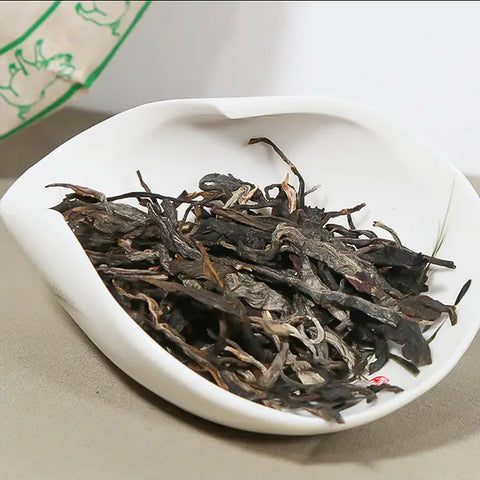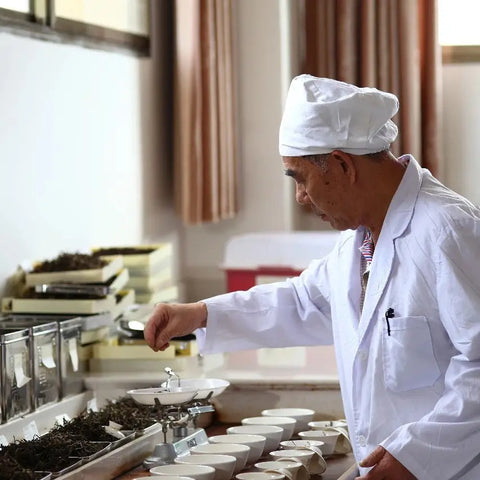How to Break Pu-erh Tea Brick
Pu-erh tea bricks have a rich history and come in various types, each offering unique characteristics and brewing experiences.
History and Origin of Pu-erh Tea
Pu-erh tea originates from Yunnan Province in China. Historically, it was produced by ethnic minorities and traded along ancient tea routes.
The tea is named after Pu'er City, a prominent trading hub. During the Tang Dynasty, Pu-erh tea was transported in compressed brick forms, making it easier to handle.
Bestsellers
Aging plays a crucial role. Over time, flavors develop and mellow, akin to aging wine. This aging process is what makes Pu-erh tea unique and sought after by tea enthusiasts.
Types of Pu-erh Tea Bricks
There are two main types: Raw (Sheng) and Ripe (Shou) Pu-erh.
Raw Pu-erh is made from sun-dried leaves and undergoes a natural aging process. It has a robust, astringent flavor when young, which softens with age.
Ripe Pu-erh undergoes an accelerated fermentation process, resulting in a dark color and rich, earthy taste. This method was developed in the 1970s to meet market demand for mature Pu-erh.
Both types come in various shapes and sizes, including bricks, cakes, and discs, offering differing experiences in flavor and aroma.
Preparing for Breakage

To effectively break a pu-erh tea brick, you need to use the right tools and ensure your workspace is properly set up. This helps prevent damage to the tea brick and ensures a clean, efficient process.
Selecting the Right Tools
Having the right tools is crucial for breaking a pu-erh tea brick. You will need a pu-erh knife or a tea needle. These tools are designed to penetrate the dense, compressed layers of the tea brick without causing excessive crumbling.
Additional Tools:
- A cutting board
- Clean cloth
- Tray to collect loose tea leaves
Tips:
- Ensure the pu-erh knife or tea needle is clean.
- Handle the tool with care to avoid injury.
Setting Up Your Workspace
Create a clean, stable workspace to break your pu-erh tea brick. Use a sturdy table or counter, ensuring there is ample lighting. Lay down a cutting board to protect your surfaces and make the tea breakage process more controlled.
Workspace Setup Steps:
Lao Ban Zhang
- Place the cutting board on a flat surface.
- Lay a clean cloth or paper towel over the cutting board.
- Position a tray nearby for collecting small pieces.
Tips:
- Ensure the workspace is free of clutter.
- Keep all necessary tools within arm's reach.
Breaking the Pu-erh Tea Brick

Successfully breaking a Pu-erh tea brick requires careful handling and attention. Knowing where to apply pressure and using the right techniques will ensure that the tea leaves remain intact.
Identifying the Pressure Lines
Look for thin, faint lines or indentations on the surface of the tea brick. These lines indicate natural break points.
Using a tea needle or a similar tool can help you find these lines more easily.
Gently feel along the surface with your fingers to identify any soft spots or weaker areas. These are the best places to start breaking the brick.
Applying Gentle Force
Once you have identified the pressure lines, insert the tea needle into one of these lines.
Apply gentle, steady pressure to avoid crumbling the leaves, twisting the needle slightly if needed.
Gradually work your way along the line, lifting the section gently as it begins to separate. Repeat this process along other pressure lines until you have broken off the desired amount of tea.
Preserving Tea Quality
To preserve the quality of your pu-erh tea, handle the tea fragments with care and store the broken leaves properly. Ensuring these practices will maintain the tea's flavor and aroma over time.
Handling Fragments with Care
When breaking a pu-erh tea brick, use a tea knife or a tea pick to gently pry apart the tea. Start by inserting the tool along the edge and work your way inward. Apply consistent, gentle pressure to avoid crumbling the leaves.
Splitting a large tea brick requires patience. Working slowly helps maintain the integrity of the leaves. Avoid forceful actions that could damage them. Keep the tea in a clean, dry environment while handling it.
Storing Broken Leaves
Once you have broken the tea, store the pieces in an airtight container. This protects them from moisture and odor contamination. Choose containers made of non-reactive materials, like ceramic or glass.
Keep the containers in a cool, dark place. Light and heat can degrade the tea’s quality over time. Ensure that the storage area is free from strong odors, as the tea can absorb these and affect its flavor.
Serving Pu-erh Tea

Properly serving Pu-erh tea involves careful measurement and effective steeping to enhance its unique flavors. Your goal is to balance the amount of tea with the right brewing time and temperature.
Measuring Portions
Measure the right amount of Pu-erh tea to ensure a balanced flavor. Use a kitchen scale for precision—typically, 3-5 grams of tea per 150 milliliters of water works well. Start with a lower amount and adjust according to your taste preference.
For loose-leaf Pu-erh, use a teaspoon or a specialized tea scoop. For compressed tea bricks, break off small chunks. Place the tea in a small bowl, then use the scale to measure.
Remember, more tea provides a stronger flavor. Adjust based on your taste and the tea’s strength.
Steeping Techniques
Use boiling water, around 95-100°C (203-212°F), for Pu-erh tea. Rinse the leaves first by pouring hot water over them, then dispose of this water. This process helps to awaken the leaves and remove impurities.
Steep the tea briefly for the first infusion, typically 20-30 seconds. Each subsequent infusion can be slightly longer. Pu-erh tea can be re-steeped multiple times, with each infusion often revealing different flavor layers.
Adjust steeping times based on the tea’s age. Older Pu-erh may require longer steeping to fully extract its flavors. Using a small pot or Gaiwan helps control the steeping process more effectively.
Maintenance and Care
Proper care of your pu-erh tea brick and cleaning of your tools are essential for preserving the quality of both the tea and your equipment. These practices ensure longevity and an authentic taste experience every time.
Cleaning Tools After Use
After breaking a pu-erh tea brick, clean your tools thoroughly to avoid residual flavors and tea debris. Use warm water and a soft brush to gently remove tea particles from any crevices of your knife or pick.
If needed, a mild dish soap can be used, but ensure all soap residues are rinsed off completely. Dry each tool thoroughly with a clean cloth to prevent rusting. Storing your tea utensils in a dry, air-tight container can keep them in optimal condition for repeated use.
Storing Pu-erh Tea Bricks Properly
Store your pu-erh tea bricks in a well-ventilated area away from strong odors, moisture, and direct sunlight. Use breathable packaging, such as paper wrapping, to allow the tea to age naturally while protecting it from dust and contaminants.
It's best to keep the bricks at a stable temperature, ideally between 20-30°C (68-86°F), with moderate humidity levels around 60-70%. Avoid using plastic bags or airtight containers, as these can trap moisture and affect the aging process. Mark your storage dates to keep track of aging progress.
← Older post Newer post →











